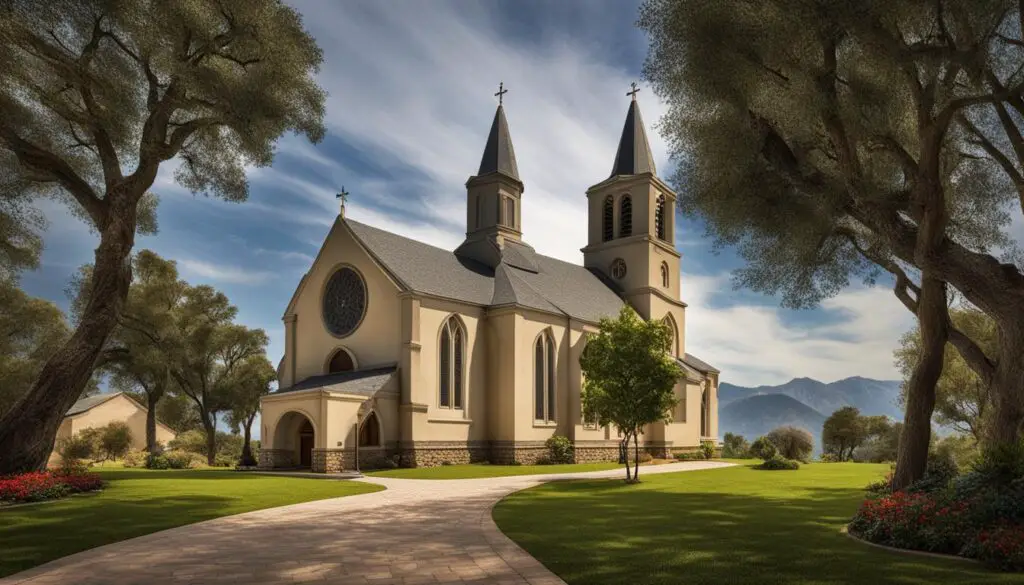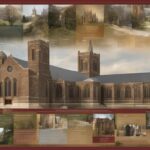The history of the entire church is a captivating journey of faith and discovery. It encompasses the origins and founders of the church, delves into key beliefs and doctrines, and explores the historical significance of the church. This comprehensive guide will provide insights into denominational splits or schisms, leadership and governance, worship practices, contemporary influence, and the current world membership number and percentage of world religions.
Key Takeaways:
- The church has deep roots in history, with its origins dating back to ancient times.
- Key figures like Jesus Christ and the apostles played a crucial role in the establishment of the church.
- The church is defined by its core beliefs and doctrines, such as the Trinity and salvation.
- The church has left an indelible mark on history through key events and milestones.
- The church has experienced various denominational splits and schisms throughout its history.
Origins and Founders of the Church
The church has a rich history that can be traced back to ancient times. Its origins can be found in the teachings of Jesus Christ and the formation of the early Christian community. Jesus Christ is considered the central figure in the founding of the church, as his teachings and actions laid the foundation for the faith. The apostles, especially Peter, Paul, and John, played significant roles in spreading the message of Christianity and establishing churches in different regions.
During the early years of the church, various Christian leaders emerged, guiding the faith and shaping its beliefs. These early Christian leaders, such as Ignatius of Antioch, Polycarp, and Clement of Rome, played pivotal roles in protecting and preserving the teachings of Jesus and ensuring the unity of the church.
As the church grew, it faced persecution and challenges. However, the teachings of Jesus and the dedication of its founders and early leaders helped the church survive and thrive. Today, the church stands as a testament to the enduring legacy of those who laid its foundations.
Key Figures in the Founding of the Church
| Figure | Role |
|---|---|
| Jesus Christ | The central figure in the founding of the church, his teachings and actions formed the basis of the Christian faith. |
| The Apostles | Key disciples of Jesus who spread his message and established churches in different regions. |
| Ignatius of Antioch | An early Christian leader who emphasized the importance of unity and loyalty to the teachings of Jesus. |
| Polycarp | A bishop known for his steadfast faith and defense of Christian beliefs during times of persecution. |
| Clement of Rome | An early pope who wrote influential letters to other Christian communities, emphasizing the authority of the Church of Rome. |
The church owes its existence to these visionary individuals who laid its foundations and ensured its continuity throughout history.
The church stands as a testament to the enduring legacy of those who laid its foundations.
Key Beliefs and Doctrines of the Church
The church is built upon a foundation of core beliefs and doctrines that shape its theology and guide the lives of its members. These principles serve as the bedrock of the faith, providing a framework for understanding the nature of God and the relationship between humanity and the divine. Here are some key beliefs and doctrines of the church:
1. The Trinity
One fundamental belief of the church is in the trinitarian nature of God. This doctrine teaches that God exists as three distinct persons—the Father, the Son (Jesus Christ), and the Holy Spirit—in one divine essence. The Trinity represents the complex unity of God and underscores the interconnectedness of the divine nature.
2. Salvation
The concept of salvation is central to the church’s teachings. It emphasizes that humanity is inherently sinful and in need of redemption. The church believes that salvation is achieved through faith in Jesus Christ, who, through his sacrificial death and resurrection, offers forgiveness and eternal life to all who believe in him.
3. Divinity of Jesus Christ
The church affirms the divinity of Jesus Christ, viewing him as the Son of God and the savior of humankind. This belief underpins the church’s understanding of Jesus as both fully human and fully divine, playing a crucial role in the redemption of humanity.
4. Authority of Scripture
The church holds the belief in the authority of scripture, considering the Holy Bible as the inspired word of God. It serves as a source of guidance, moral teachings, and revelation about God’s plan for humanity. The church upholds the Bible as a sacred text and seeks to follow its teachings in all aspects of life.
These key beliefs and doctrines shape the worldview and practices of the church, providing a foundation of faith for its members. They serve as a guide for understanding God, salvation, the nature of Jesus Christ, and the authority of scripture within the context of the church’s theology.
Historical Significance of the Church
The church has a rich and significant history that has shaped society and culture throughout the years. From its early beginnings to its influence on major historical events, the church’s development and evolution have left an indelible mark on the world. Understanding the historical significance of the church provides insights into its enduring impact and relevance.
Key Historical Events
The church has been intertwined with numerous historical events that have shaped its development. One such event is the spread of Christianity in the early centuries, as missionaries traveled to different regions, spreading the teachings of Jesus Christ. The conversion of Constantine the Great in 313 AD marked a turning point for the church, as Christianity became the official religion of the Roman Empire.
The Reformation, which began in the 16th century, was another pivotal moment in church history. It led to the formation of various Protestant denominations and challenged the authority of the Roman Catholic Church. The Reformation movement sparked social, political, and religious changes that reverberated throughout Europe and beyond.
Evolution of the Church
Throughout its history, the church has evolved in response to societal changes and theological developments. The establishment of doctrines and the formation of the canon of scripture played a crucial role in defining the beliefs of the church. Over time, the church has adapted to cultural shifts, embracing new forms of worship and engaging with contemporary issues.
Church Development
The church has expanded its influence around the world, with the establishment of missionary work and the growth of global membership. As the church spread to different continents, it encountered diverse cultures and incorporated local customs into its practices. This development has contributed to the rich tapestry of the church’s global presence.

| Historical Event | Impact on Church |
|---|---|
| The Conversion of Constantine the Great (313 AD) | Official recognition of Christianity in the Roman Empire |
| The Great Schism (1054 AD) | Split between the Eastern Orthodox Church and the Roman Catholic Church |
| The Protestant Reformation (16th century) | Formation of various Protestant denominations |
| The Second Vatican Council (1962-1965) | Modernization and reforms within the Roman Catholic Church |
Denominational Split or Schisms in the Church
Throughout its history, the church has experienced various denominational splits and schisms, leading to the formation of different branches and traditions within Christianity. These divisions have shaped the landscape of the church, resulting in diverse theological beliefs, worship practices, and organizational structures.
One of the most significant schisms in church history is the Great Schism of 1054, which led to the permanent division between the Eastern Orthodox Church and the Roman Catholic Church. The split was primarily driven by differences in theology, ecclesiastical authority, and cultural and political factors. Today, the Eastern Orthodox Church and the Roman Catholic Church remain distinct entities with separate hierarchies and liturgical traditions.
Another major schism occurred during the Protestant Reformation in the 16th century when reformers such as Martin Luther, John Calvin, and Huldrych Zwingli challenged the teachings and practices of the Roman Catholic Church. This led to the formation of various Protestant denominations, each with its own distinct theology and worship style. The Protestant movement further fragmented over time, resulting in the emergence of numerous denominations, such as Lutheranism, Calvinism, Anglicanism, and Anabaptism.
| Denomination | Year Founded | Key Beliefs |
|---|---|---|
| Lutheranism | 1517 | Justification by faith alone, sacraments, priesthood of all believers |
| Calvinism | 16th century | Predestination, sovereignty of God, importance of Scripture |
| Anglicanism | 1534 | Episcopal hierarchy, Book of Common Prayer, scripture and tradition |
| Anabaptism | 16th century | Baptism of believers, separation of church and state, nonviolence |
These denominational splits and schisms within the church have led to a rich tapestry of beliefs and practices, reflecting the diversity of Christian thought and worship. While these divisions have sometimes caused tensions and conflicts, they have also contributed to the vibrant and evolving nature of the church.
Leadership and Governance of the Church
The leadership and governance of the church play a crucial role in guiding its members and ensuring the smooth operation of its various activities. The hierarchical structure of the church is designed to provide accountability, support, and direction. At the top of the hierarchy are bishops, who hold positions of authority and oversee the spiritual and administrative matters within their respective regions or dioceses.
Working alongside the bishops are priests, who are responsible for the day-to-day pastoral care of the church’s congregations. They lead worship services, administer sacraments, offer spiritual guidance, and serve as a bridge between the church leadership and its members. Other clergy members, such as deacons, also play significant roles in the church’s leadership and governance.
Church Governance
The decision-making processes within the church are guided by various governance structures, such as councils, synods, and committees. These bodies are composed of clergy and lay members who represent the different constituencies within the church. They meet regularly to discuss and make decisions on matters of doctrine, church policy, and organizational management.
The governance structures of the church ensure that the leadership is accountable and that decisions are made collectively, taking into consideration the diverse perspectives and experiences of its members. This ensures a balanced and inclusive approach to the church’s governance, allowing for the effective management of its resources and the fulfillment of its mission.
Overall, the leadership and governance of the church provide the framework for its operations and ensure that it remains faithful to its core beliefs and values. With strong and accountable leadership, the church can effectively minister to its members, address the needs of its community, and contribute to the wider society.
Worship Practices in the Church
Worship is the heart and soul of the church, encompassing a wide range of practices that vary across different denominations. From liturgical traditions to contemporary expressions, worship plays a vital role in the spiritual life of church members. It is a time of reverence, devotion, and communion with the divine.
Liturgical Traditions: Many churches follow a liturgical format for their worship services, which includes structured prayers, responsive readings, hymns, and sacraments. This form of worship often follows a set order or ritual, providing a sense of familiarity and continuity. Examples of liturgical traditions include the Catholic Mass, the Lutheran Divine Service, and the Anglican Book of Common Prayer.
Sacraments: The church practices various sacraments, which are sacred rites or rituals that symbolize and convey spiritual truths. The most widely recognized sacraments are baptism and the Eucharist (also known as Communion or the Lord’s Supper). Baptism signifies initiation into the church, while the Eucharist represents the commemoration of Jesus’ Last Supper and his sacrifice on the cross.
Worship is the heart and soul of the church, encompassing a wide range of practices that vary across different denominations.
Prayers, Hymns, and Rituals: In addition to structured prayers and sacraments, worship often includes spontaneous prayers, hymns, and rituals that reflect the specific beliefs and traditions of each denomination. These elements provide an opportunity for congregational participation, allowing individuals to express their faith, devotion, and gratitude to God.
Contemporary Expressions: In recent years, many churches have embraced more contemporary forms of worship, incorporating modern music, multimedia presentations, and interactive elements. These services often create a more relaxed and informal atmosphere, encouraging active engagement and personal connection with God.
Overall, worship practices in the church are diverse and dynamic, reflecting the rich tapestry of beliefs, traditions, and cultural expressions within the faith. Whether through liturgical traditions or contemporary experiences, worship serves as a time of spiritual connection, renewal, and community for believers.
The Power of Worship
Worship holds a significant place in the life of the church, as it is not merely a religious ritual but a powerful and transformative practice. It provides a space for individuals to connect with the divine, express their faith, and experience spiritual renewal. The act of worship fosters a sense of unity among believers, reinforcing the shared values and beliefs that bind them together in their faith journey.
| Benefits of Worship | Scriptural Reference |
|---|---|
| Draws believers closer to God | Psalm 95:6, James 4:8 |
| Fosters spiritual growth and transformation | 2 Corinthians 3:18, Romans 12:1-2 |
| Creates an atmosphere of reverence and awe | Psalms 99:5, Hebrews 12:28-29 |
| Builds community and encourages fellowship | Hebrews 10:24-25, Acts 2:42-47 |
| Strengthens believers’ faith and trust in God | Psalm 28:7, Isaiah 26:3-4 |
As believers gather in worship, they are reminded of God’s presence, love, and grace, which empowers them to face the challenges of life with hope and courage. Worship is a sacred time of communion with the divine, fostering spiritual intimacy and transformation.
While worship practices may differ across denominations, the essence remains the same—to honor, praise, and encounter God. Through prayer, song, and ritual, believers find solace, inspiration, and a deep sense of connection with the divine presence.
Contemporary Influence of the Church
The church continues to have a significant influence on society and culture in the modern world. It plays a crucial role in shaping ethical frameworks, advocating for social justice, contributing to education, and engaging in charitable work. The church’s influence is seen in various aspects of society, making it an essential institution that impacts the lives of individuals and communities.
One area where the church exerts its influence is in the realm of ethics. It provides moral guidance and principles that help individuals navigate complex issues and make ethical decisions. The teachings of the church often promote compassion, empathy, and the value of human life, forming the foundation for ethical behavior in society.
Furthermore, the church is actively involved in advocating for social justice. It champions causes such as human rights, racial equality, gender equality, and the eradication of poverty. Through its teachings and initiatives, the church aims to create a more just and equitable society, addressing systemic issues and working towards positive change.
In addition to its ethical and justice-oriented efforts, the church is also deeply involved in education. Many religious institutions run schools, colleges, and universities that provide quality education to students worldwide. These educational institutions often prioritize holistic development, combining academic excellence with values-based education and character formation.
Moreover, the church is actively engaged in charitable work, providing assistance and support to vulnerable populations. It runs numerous initiatives such as food banks, homeless shelters, healthcare clinics, and disaster relief programs. These efforts reflect the church’s commitment to serving those in need, demonstrating compassion and solidarity in practical ways.
Overall, the contemporary influence of the church extends far beyond its religious practices. It has a substantial impact on society through its ethical teachings, social justice advocacy, educational initiatives, and charitable work. As the church continues to navigate the challenges of the modern world, its influence remains a vital force in shaping the values, attitudes, and actions of individuals and communities.
Current World Membership and Percentage of World Religions
The church has a worldwide presence, with millions of adherents across the globe. Its current world membership number and percentage in relation to other major world religions provide valuable insights into the global reach and significance of the church.
According to recent statistical data, the church has a total worldwide membership of approximately 15 million individuals. While this number represents a significant portion of the global population, it is important to note that the church’s membership percentage in relation to other world religions is relatively small. However, the impact and influence of the church extend far beyond its numerical representation.
In a world where religious diversity is prevalent, the church’s membership number and percentage highlight its unique position among other major world religions. While it may not have the large numbers of adherents seen in other religious traditions, the church’s teachings and practices continue to resonate deeply with its members and shape their spiritual lives.
| World Religion | Membership (Approx.) | Percentage |
|---|---|---|
| Christianity | 2.4 billion | 32.12% |
| Islam | 1.9 billion | 24.1% |
| Hinduism | 1.2 billion | 15.16% |
| Buddhism | 535 million | 6.75% |
| Sikhism | 30 million | 0.38% |
| Church | 15 million | 0.19% |
“It’s not about the quantity of members, but the quality of their faith and commitment.”
The church’s influence is not solely determined by its membership numbers or its percentage among world religions. It is a faith community that fosters deep spirituality, provides guidance and support, and promotes positive values that resonate with its members. The church’s impact on society, culture, and the lives of its members cannot be quantified solely based on these statistics, but rather through the transformative power it holds for those who embrace its teachings.
While the church’s current membership number and percentage may be modest compared to other world religions, its ongoing presence and the spiritual nourishment it offers to its members make it an integral part of the global religious landscape.
The Impact of the English Church during the Civil Wars and Commonwealth
The English Church holds a significant place in history, particularly during the turbulent periods of the Civil Wars and Commonwealth. These periods were marked by intense religious and political struggles, which profoundly impacted the English Church and its role in society.
During the Civil Wars, which lasted from 1642 to 1651, the English Church faced tremendous challenges. The conflicts between the Royalists and the Parliamentarians led to divisions within the church itself. The Church of England, as the established church, was closely aligned with the monarchy and faced opposition from various factions seeking religious reform. This resulted in tensions and conflicts between those who supported the traditional practices of the church and those who advocated for more radical changes.
The Commonwealth, established after the execution of King Charles I in 1649, marked a period of dramatic change for the English Church. Under the leadership of Oliver Cromwell, the Commonwealth government sought to reform and reshape the church according to Puritan ideals. Many traditional practices, such as the use of elaborate liturgical forms, were abolished, and a more simplistic and austere approach to worship was promoted.
Despite these challenges, the English Church survived and eventually experienced a restoration of sorts with the return of the monarchy in 1660. The impact of the Civil Wars and Commonwealth on the church cannot be understated. It spurred debates and discussions about religious freedom, the relationship between church and state, and the role of religion in society. These debates continue to shape the English Church and its place in modern society.
Key Events during the Civil Wars and Commonwealth
The English Church underwent significant changes during the Civil Wars and Commonwealth. Here are some key events that shaped its history during this period:
- The execution of King Charles I in 1649, marking the end of the monarchy and the beginning of the Commonwealth.
- The abolition of the monarchy and the establishment of a republican government under Oliver Cromwell.
- The suppression of traditional practices within the English Church, including the removal of stained glass windows, statues, and other decorative elements from churches.
- The rise of Puritanism and the promotion of more simplistic and austere forms of worship.
- The publication of religious texts, such as the Westminster Confession of Faith, which outlined the beliefs and practices of the reformed church.
The impact of these events on the English Church was profound and far-reaching. They set the stage for future debates and developments within the church, shaping its identity and role in English society. Understanding this history is crucial to comprehending the complexities of the English Church today.
| Aspect | Impact |
|---|---|
| Religious Freedom | The conflicts during the Civil Wars and Commonwealth led to discussions and debates about religious tolerance and freedom, laying the groundwork for future developments in these areas. |
| Relationship between Church and State | The abolition of the monarchy and the establishment of a republican government raised questions about the relationship between church and state. These debates continue to influence the dynamics between religion and politics in England. |
| Church Governance | The Commonwealth period saw significant changes in the governance of the English Church, with power shifting from bishops to local clergy and religious assemblies. This had lasting implications for the structure and organization of the church. |
| Theological Shifts | The rise of Puritanism and the promotion of reformed theology during the Commonwealth period influenced the beliefs and practices of the English Church. These theological shifts continue to shape various denominations within the church. |
The impact of the English Church during the Civil Wars and Commonwealth cannot be overstated. It was a period of intense religious and political upheaval that shaped the trajectory of the church and influenced its role in society. Understanding this history is essential for comprehending the complexities of the English Church today.

The Joseph Smith Papers and the Unveiling of Early Church History
The Joseph Smith Papers project has revolutionized our understanding of early church history. Through meticulous research and documentation, this project has uncovered new insights into the life of Joseph Smith, the founding prophet of the Church of Jesus Christ of Latter-day Saints, and the early legal cases that shaped the church’s development.
One of the groundbreaking discoveries of the Joseph Smith Papers project is the publishing of the Council of Fifty minutes, previously unavailable to the public. These minutes provide a unique glimpse into the religious, political, and social aspirations of Joseph Smith and his followers during a pivotal time in church history.
The project has also shed light on the complexities of early Mormonism and the challenges faced by the early church. It explores topics such as polygamy, the translation of the Book of Mormon, and the establishment of Nauvoo, a thriving Mormon community in Illinois. The Joseph Smith Papers project serves as a valuable resource for historians, scholars, and anyone interested in understanding the early years of the church.
Through the Joseph Smith Papers project, the early history of the church has come alive in a new and engaging way. It offers a deeper understanding of the experiences, struggles, and visionary leadership of Joseph Smith and the early members of the church. This project reaffirms the significance of early church history and its enduring impact on the lives of millions around the world.

| Key Discoveries: | Impact: |
|---|---|
| The Council of Fifty minutes | Provides insights into the aspirations of Joseph Smith and his followers |
| Polygamy | Explores the complexities of early Mormonism |
| The translation of the Book of Mormon | Offers a deeper understanding of the foundational scripture of the church |
| The establishment of Nauvoo | Highlights the growth and challenges of a thriving Mormon community |
Conclusion
The history of the entire church is a fascinating tapestry of faith, resilience, and evolution. From its origins and founders, such as Jesus Christ and the early Christian leaders, to its key beliefs and doctrines, the church has left an indelible mark on history.
Throughout the centuries, the church’s historical significance has shaped society and culture in profound ways. From the spread of Christianity to the impact of the Reformation, the church has played a pivotal role in shaping the world we live in today.
The church’s journey has not been without challenges, as denominational splits and schisms have led to the formation of various denominations. Despite these divisions, the church has maintained its core principles and continues to guide its members through strong leadership and governance structures.
Worship practices are central to the church’s spiritual life, with diverse forms of worship, such as liturgical traditions and sacraments, bringing believers closer to their faith. The church’s contemporary influence remains significant, impacting various aspects of society, including ethics, social justice, education, and charity work.
With a current world membership and percentage among world religions, the church’s global reach and significance cannot be underestimated. As we delve into the rich history of the church, we gain insights into the journey of millions of individuals and communities who have been deeply influenced by its teachings and values.
FAQ
What is the history of the entire church?
The history of the entire church is a captivating journey of faith and discovery, encompassing its origins, founders, key beliefs, historical significance, and contemporary influence.
Who were the founders of the church?
The founders of the church include Jesus Christ, the apostles, and early Christian leaders who played a crucial role in its establishment.
What are the core beliefs and doctrines of the church?
The church’s core beliefs and doctrines include the Trinity, salvation, the divinity of Jesus Christ, and the authority of scripture.
How has the church influenced society and culture throughout history?
The church has played a significant role in shaping society and culture, from the early spread of Christianity to the impact of the Reformation and beyond.
What are the reasons behind the denominational splits in the church?
Denominational splits in the church have occurred due to various factors, such as religious differences, theological disagreements, and historical events like the Protestant Reformation.
How is the church organized and governed?
The church is organized and governed by a hierarchical structure, with leadership roles like bishops, priests, and clergy members, as well as governance structures like councils and synods.
What forms of worship are practiced in the church?
The church practices various forms of worship, including liturgical traditions, sacraments, prayers, hymns, and rituals.
How does the church continue to influence society in the modern world?
The church impacts various aspects of society, including ethics, social justice, education, and charity work, maintaining its relevance and influence in today’s world.
What is the current world membership of the church?
The church has a worldwide presence, with millions of adherents across the globe. Statistical data on the current world membership and its percentage in relation to other major world religions can provide insights into its global reach and significance.
What was the impact of the English Church during the Civil Wars and Commonwealth?
The English Church had a significant impact on the political landscape and religious tensions during the Civil Wars and Commonwealth period.
What insights have been gained from the Joseph Smith Papers project?
The Joseph Smith Papers project has shed light on previously unknown or misunderstood aspects of early church history, including Joseph Smith’s life, early legal cases involving the church, and the publishing of the Council of Fifty minutes.
















